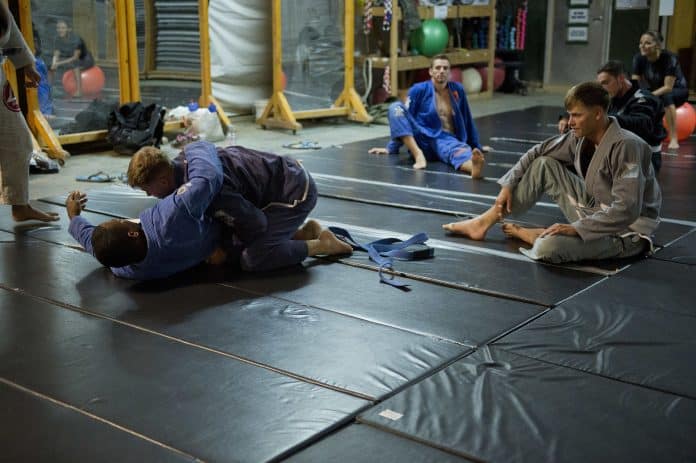Forty-four years old, sitting in my car, unsure if I could sum up the courage to actually go in and try something new.
For a bit of history, I did Karatae as a kid (Yellow/Orange Belts), Kendo for years (Brown), and Tai Chi (unranked?) for many more – this wasn’t my first ‘foray’ into Martial Arts. I taught people to shoot rifles for years and held many Firearms Licencing courses. So – what was making me so nervous?
I guess. It was simply something new and a fear of looking silly.
Indeed, stepping into a new environment, especially one as intense as a BJJ dojo, can feel intimidating. The fear of the unknown and the worry of appearing inexperienced or clueless can sometimes hold us back. It’s a universal feeling we’ve all grappled with (pun absolutely intended) – but fear not, this guide will arm you with all you need to confidently approach your first BJJ lesson.
The journey of a thousand miles begins with a single step.
– Lao Tzu
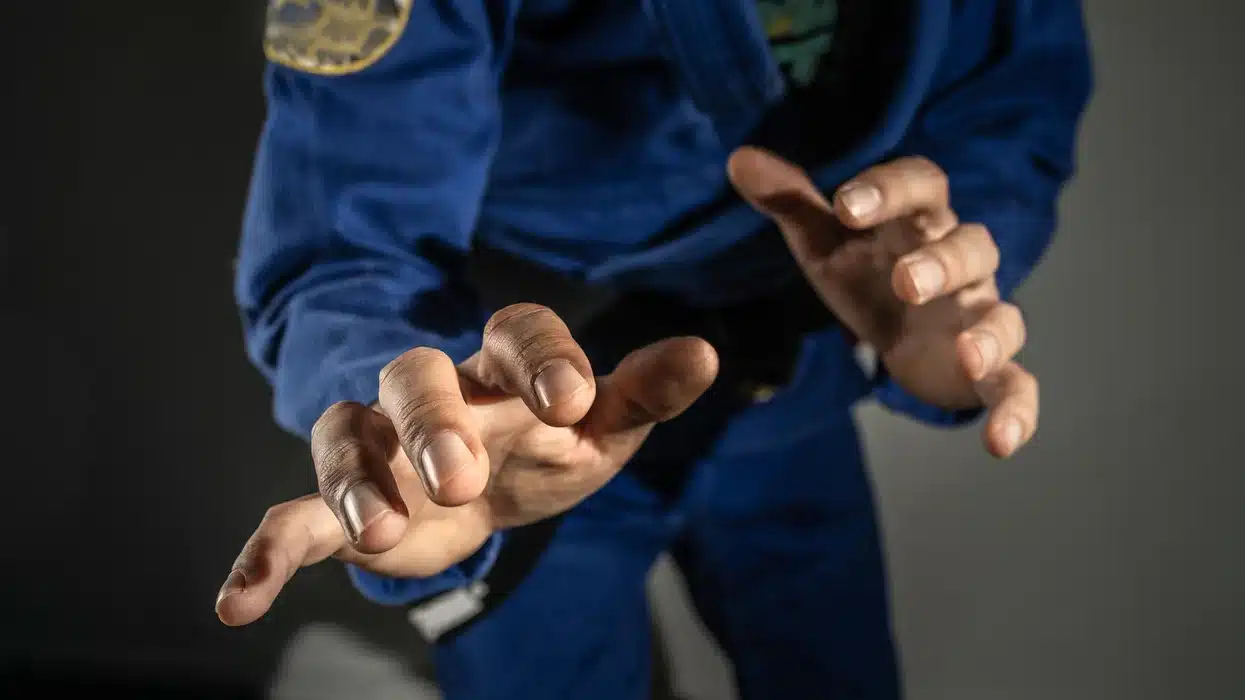
What is Brazilian Jiu Jitsu?
I am writing a bit of a long answer to this one – as I find myself needing to do some research for my kids on the subject, but, as a short history: Brazilian Jiu Jitsu, often abbreviated as BJJ, traces its roots back to the Japanese martial art of Judo in the late 19th century. The Gracie family later modified it in Brazil to become the physical chess game we know today. Notably, BJJ focuses less on strikes and more on ground fighting and grappling, with the objective being to control and subdue your opponent through superior technique, leverage, and body positioning. It’s a challenging and rewarding sport requiring physical and mental prowess.
How do I find a reputable Brazilian Jiu Jitsu school?
This is a bit tricky because – you don’t know what you don’t know. Location obviously plays a big part, but other than that – knowing someone who already goes there is a big plus and the general feel you get on their website. But more than anything, you have to feel comfortable there. And you will only know that when you step into the dojo. So go ahead and take that leap of faith because every great journey begins with a single step, doesn’t it?
The best way to predict the future is to create it.
– Peter Drucker
Do I need any prior experience to attend a Brazilian Jiu Jitsu lesson?
No. Not really. Indeed, prior martial arts or sports experience will undoubtedly help, but the key is an open mind. Many seasoned practitioners started off with little to no experience and learned along the way.
Do I need to be physically fit to participate in Brazilian Jiu Jitsu?
I certainly wasn’t! My BBJ journey has been frustrating as I realised I wasn’t as fit as I would like to be and found myself (still do) gassing out while rolling with a more athletic opponent. Don’t worry – practice consistency, and through the beautiful ability of the human body to adapt – it will get easier, and you will get fitter!
It’s true that Brazilian Jiu Jitsu (or BJJ) can be a rather intensive form of exercise, requiring a fair bit of strength and agility. But here’s the crux of the matter – you don’t need to possess these attributes at the onset. As you progress in your training, your fitness level will naturally improve. Plus, instructors understand that everyone starts somewhere and are there to guide you from your current fitness level rather than expect you to be a grappling superhero from day one. So, if you’ve been watching from the sidelines thinking you’re not ‘fit enough’ to join in, it’s time to toss that excuse out of the ring!
BJJ is a martial art that champions technique over raw physical prowess. You’ll rely more on your wit and strategy than on hulking muscles. Yes, the thought might strike you as peculiar. Can one really out-manoeuvre an opponent in a physical combat sport without bulging muscles and a chiselled six-pack? The answer is a resounding ‘yes’. In fact, some of the most successful BJJ practitioners aren’t specimens of Herculean strength but are individuals who’ve mastered technique and timing.
Does all of this mean fitness doesn’t matter in BJJ? Not quite. Improved fitness can offer advantages like better stamina or faster recovery times. But remember, it’s a progression, not a prerequisite. So, keep those worries about your fitness level at bay, lace up your shoes (or rather, wrap up your gi!) and step out on the mat. As the old saying goes – the journey of a thousand miles begins with a single step….or in this case, a single roll!
What should I wear to my first Brazilian Jiu Jitsu lesson?
If in doubt, ask. The school will undoubtedly be happy to answer questions – but – in short – comfortable gym gear. However – that means shorts or trackies – without any massive pockets or other things to catch fingers and toes (been there, done that – even on a GI, it still can be a pain!) with a t-shirt. Skip the singlet and – pro-tip – ear jandels to the gym to let your feet air beforehand because you won’t wear shoes while training. Make sure your attire is convenient, non-hazardous, and feet-friendly. Your initial sessions will be more about learning the ropes than style, so comfort trumps fashion in the BJJ dojo/gym/school.
What to wear on your feet
You might be wondering: ‘What should I wear on my feet to a BJJ gym?’ Good question! Unlike other sports, BJJ is typically practised on mats and requires bare feet. Don’t panic if you’re not accustomed to this – the mat is generally soft, and you’ll get used to the sensation with time.
The Role of Flip-flops or ‘Jandals’
Now here comes the quirky part. Jandals! Yes, you read it right. The protocol in most BJJ schools is to wear flip-flops or jandals when you’re not on the mat. Wearing them when you visit the bathroom or move about off the mats in the gym is required. In doing so, you’re safeguarding your bare feet from germs and dirt, making it a healthier space for your BJJ comrades.
Feet Cleanliness
It goes without saying, but I will say it anyway – if you’ve been out in the wild in your jandals and you’ve stepped in some muck (it happens), do wipe down your feet before stepping on the mat.
- Most gyms will have antibacterial wipes or sprays for this purpose.
- Just give your feet a good wipe-down, and you’re ready!
Adhering to these practices isn’t just about keeping the gym clean or honouring the traditions of BJJ – it’s also about ensuring that you and whoever you’re grappling with can train safely and effectively.

What are some standard etiquette practices in Brazilian Jiu Jitsu?
Hygiene and Cleanliness Etiquette
Delving into the realm of Brazilian Jiu Jitsu, it’s pivotal to uphold a stellar standard of hygiene and cleanliness. I know hygiene hardly seems the most exhilarating topic, but trust me, it’s essential considering the level of physical contact in this martial art. You’ll soon discover that keeping clean isn’t just for your benefit but for everyone sharing the mat with you.
Keep It Clean
First things first, your Gi needs to be spotless for every lesson when you get it – that’s your uniform if we’re still acquainting ourselves with the lingo. A grubby Gi is a shocking offence in the BJJ community. Not only is it unhygienic, but also disrespectful to your training partners who, let’s face it, don’t want to get up close and personal with last week’s sweat stains.
I wash mine every time I train – it just goes into the washing machine for a quick cycle with some Antibacterial Laundry Sanitiser. Quick, fresh, minty. Well – Eucalyptus, actually.
Wash Up
Washing before training is a must. You’ll be physically close with your training peers, snugglier than traditional social norms tend to consider acceptable. As such, arriving fresh and smelling neutral is essential. While ideally, you might shower pre-roll – at the minimum – don’t work straight off a hot, dirty worksite straight into the gym. A spritz of deodorant is great, but steer clear of strong perfumes or colognes – when you’re gasping for breath mid-roll, the last thing you need is a lungful of someone’s pungent aftershave. Remember – cleanliness is not only next to godliness in BJJ; it’s respect for your fellow training partners.
Consider also bringing a little bottle of hand sanitiser – a quick spray before you step onto the mat – and you will deal with anything you might have picked up on the way to the gym.
Trim Them Nails
If you thought your first Brazilian Jiu Jitsu lesson was about grappling mats, think again! BJJ is an up-close and personal martial art; thus, personal grooming is more important. One simple yet crucial component of this is the state of your nails. Fingernails, as well as toenails, need to be frequently checked and maintained. But why, you ask? Well, I’m glad you asked!
The reason may sound obvious, but we should spell it out anyway – nobody wants to be scratched during training! Long, sharp nails are a hazard for you and your partners. And remember, we’re practising martial arts, not auditioning for a horror movie.
There’s more bad news for those worried about breaking a nail (and we know you’re out there). Long nails are more prone to painful breaks and tears during the rough and tumble of BJJ training. In the spirit of empathy, let’s avoid inflicting or suffering from such unnecessary agonies, shall we?
So, before arriving at your first class, ensure your nails are neatly trimmed. It’s a small but essential step in preparing for the BJJ mat. After all, big journeys come from small beginnings and trust me when I say your BJJ journey will be big. So, break out those clippers, take a deep breath, and engage in one of the simplest but most impactful preparation rituals for your BJJ journey. Trust me, your future training partners will thank you!
Mind that Breath
Before we proceed, could we take a moment to talk about our breath? Smelly breath should be classified as a martial art on its own, ‘halitosis-jitsu’, if you will. It’s powerful – powerful enough that your sparring partner could tap out before you even demonstrate that complex armbar you’ve been perfecting. Jokes aside, it is imperative to take care of your oral hygiene.
Frequently sipping on energy drinks or malfunctioning protein shake sippers right before a grappling session can give you a set of gnashers that even a great white shark would consider offensive. And if you’re wondering, yes, the smell does get amplified under the duress of intense submission grappling. Do you really want your new gym buddies to remember you as ‘the one with the breath’?
Here’s a tip, make brushing and flossing a part of your pre-GI routine! It’s a good practice to bring along some chewing gum for last-minute refreshment (the sugar-free kind, of course, we wouldn’t want to aid any cavity-causing bacteria, would we?).
In addition, stay hydrated throughout the class. Rollers often suffer from dry mouth due to intense exertion and heavy breathing, leading to malodorous breath. So, help your mouth maintain its natural clean cycle by staying hydrated.
These might seem trivial details, but they promote a healthy, respectful, and friendly training environment. After all, the art of Brazilian Jiu Jitsu also teaches us the importance of discipline, respect and cleanliness, doesn’t it? So arm yourselves with a winning smile and minty breath, and get ready to immerse yourself in the beautiful world of Brazilian Jiu Jitsu.
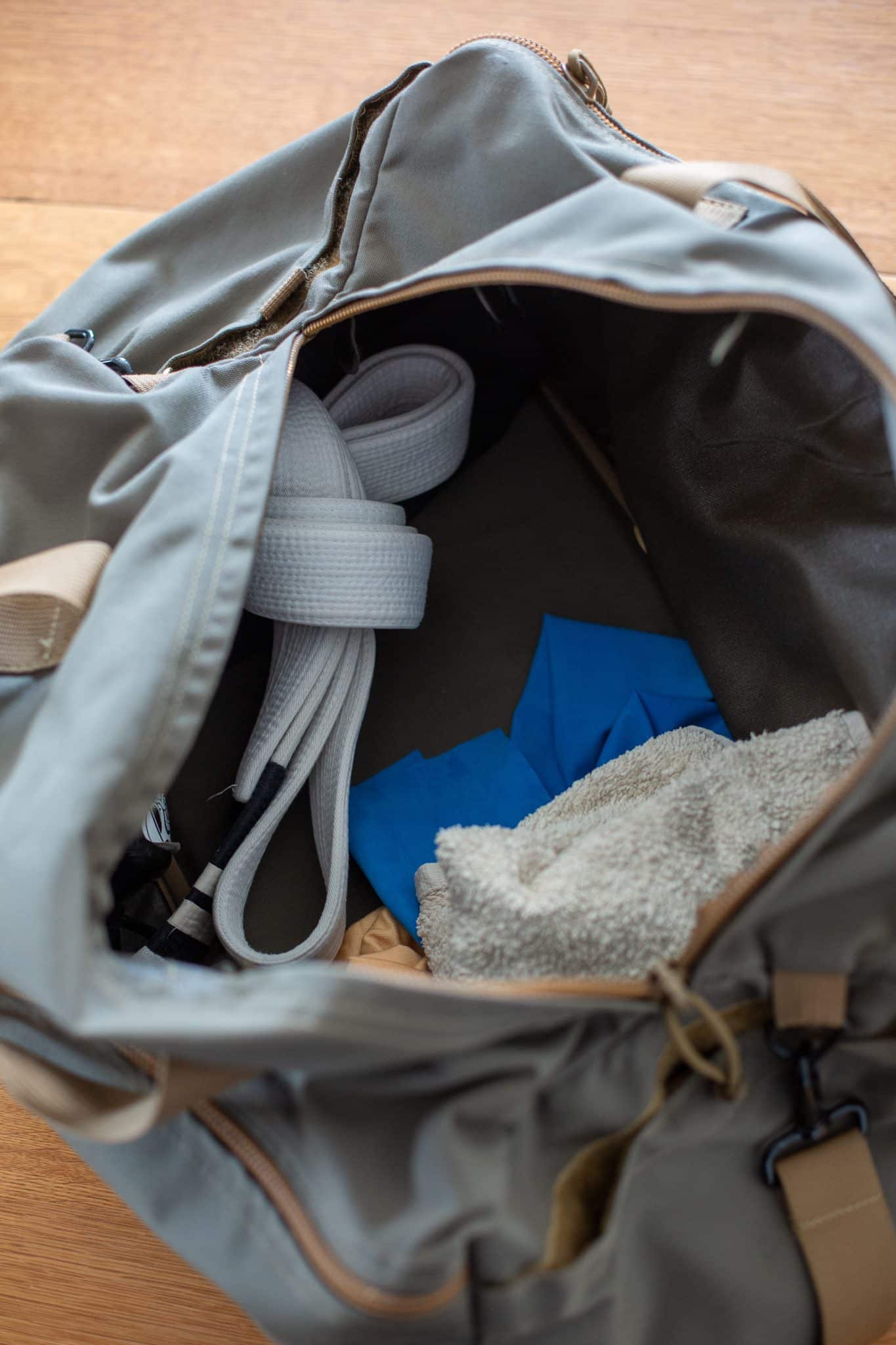
Bring a Gym Towel
Here’s something that might not automatically spring to mind when you’re packing your bag for your first Brazilian Jiu Jitsu lesson – a gym towel. It’s like Bruce Lee once said, “Be water, my friend” – and trust me, you will be. In this form of martial arts, a good old sweat sesh is pretty much a given, and a towel can be a little lifesaver in such moments.
Why, you might ask? Well, Brazilian Jiu Jitsu is a close-contact sport. Emphasis on the close contact. When sparring, you’ll find yourself closer to your training partner than you may be used to, and depositing a river of sweat on them isn’t exactly considered the height of good manners. Your gym towel is your trusty sidekick in maintaining cleanliness and diplomacy in the dojo.
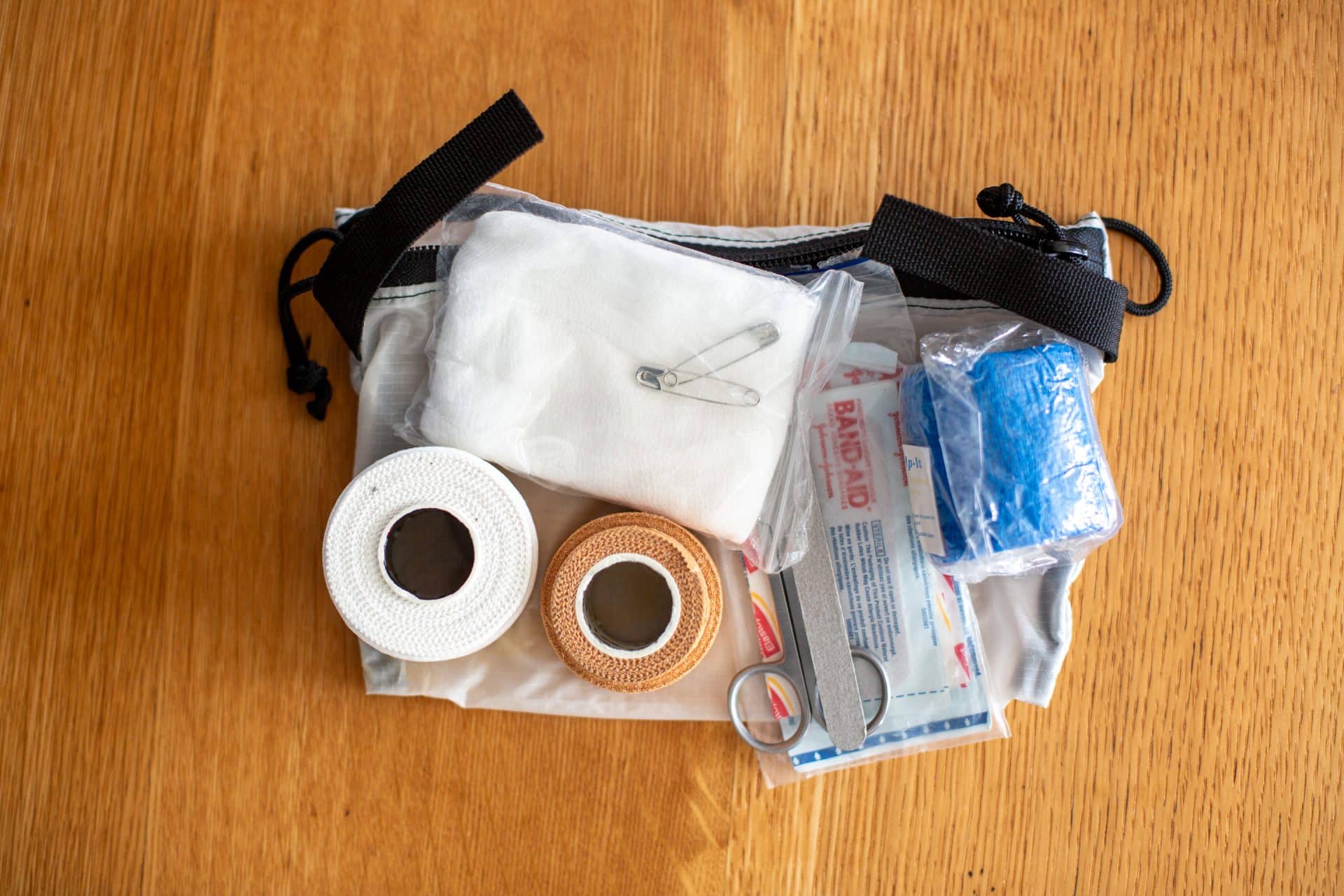
First Aid Kit Essentials
Imagine this – you’re heading off to your first Brazilian Jiu Jitsu lesson, and you’re packed with adrenaline, excitement and maybe – just maybe – a tiny dash of apprehension. As you go to the gym, consider this little pearl of wisdom I will share with you (it might just save the day). Ensure your gym bag is always armed with a basic first-aid kit. Sounds obvious, right? But you’d be surprised at how often this is overlooked.
We all experience our fair share of scuffs and scrapes in life, but trust me when I say they’re common in martial arts. Thus, the first rule of Jiu Jitsu? If you’ve got an open wound, cover it before stepping onto the mat! For this, my friends, adhesive tape is your trusty ally.
And here’s the thing – remember to bring your own tape! If you are burdened by an unexpected cut, your coach would probably not mind sparing a piece of their precious tape. However, if you’re aware of a wound, your own roll of tape will come in handy. I say tape because most sticking plasters will not hold on long in the conditions you subject them to.
Let’s shift gears for a moment – suppose you’re in the middle of training, and bam! The new, over-excited white belt accidentally gives you a nosebleed. What should you do? Ignore it and continue training? Absolutely not! I wouldn’t recommend smearing it around with a paper towel, either. Fear not, for there’s a simple solution – get hold of some antiseptic wipes or any mat-friendly disinfectant and promptly clean it up.
- Adhesive tape
- Antiseptic wipes
- Nail clippers
- Hand Sanitiser
There you have it, four must-have items in your first-aid kit for the gym. Small steps like these ensure a safe and enjoyable training experience for you and everyone else on the mat.
On Arrival At The Gym
Introduce Yourself
You might walk into your first Brazilian Jiu Jitsu (BJJ) lesson feeling a tad nervous – a cocktail of excitement and anxiety, perhaps. Nothing strange there, I assure you. We’ve all been there, done that, and worn our first Gi (which felt a bit like wearing a pair of rough curtains, I’ll admit).
One of the first steps in your soon-to-be-favourite martial arts adventure is as simple as saying ‘hello’. That’s right, you need to introduce yourself. It might sound too easy or even a tad trite, but trust me on this one, a good introduction often paves the way for an enjoyable BJJ journey.
While not every school will have the same introduction procedures, meeting the instructor before the class begins is standard practice. So be early. You’ll most likely need to fill out some basic paperwork and disclose any medical conditions or physical limitations you might have while you’re at it. Then, make sure to introduce yourself to your fellow students when you step onto the mat. While you might feel like the new kid in town, remember that every current student was once where you are now, and they’re there to support your journey, not hinder it. Your BJJ journey, after all, is not a solo trek but a team sport. Pro-tip – if people are not friendly, it might be worth looking for another gym to join.
Remember, the first step to being good at something is being bad at it. In essence, BJJ is a lifestyle, a discipline that teaches you life skills, values respect, and promotes the spirit of camaraderie. So take that first step, introduce yourself, and prepare to immerse in an oh-so-capacious world of Brazilian Jiu Jitsu. It’s not just about the fisticuffs, my friends.
What should I expect during my first Brazilian Jiu Jitsu lesson?
Personal Space
It’s going to get close and personal. One major difference I immediately noticed between any other martial art I had previously done, and BJJ is that you will very quickly be put into a rather close and personal situation with another person. Physically close. Like, real close. Chest to chest. It will be (naturally) a bit uncomfortable for a bit. Don’t worry. That’s normal – and – any discomfort from the situation will quickly get replaced with the discomfort of being in a situation trying to defend yourself. That tends to refocus your mind really fast! Remember, everyone in a BJJ class has been exactly where you are now, on the first day, feeling a tad out of sorts when getting up close and physical with a stranger. In no time at all, you’ll find that the physical closeness fades into the background as your focus narrows to strategy, techniques, and survival. Embrace the close quarters – it’s all part and parcel of this incredible martial art!
What About Rolling With Woman?
Assuming I am talking to a male here, I think the opposite is also likely true (though out of my experience) – to put it – most of us guys will initially be a little wary of being between the legs of a woman, other than our partner. Again, this discomfort is normal and natural, and we’re operating under an unspoken but implicitly understood contract of mutual respect here; we’re training partners, nothing else. As soon as you get choked- you will forget who they are – and focus on getting some blood back to your brain!
But where do I put my hands?
Just put your hands where the job needs them to be! Grappling lapels is A-okay, gripping legs is peachy and anything that the technique demands is fair game. Of course, there might be the odd unintentional brush-by as your hand voyages to its destination (and believe me, it’d better be unintentional). If this happens, offer a swift but sincere apology and crack on.
Here’s a little insider nugget – this isn’t just an etiquette for engaging with folks of the opposite sex. You’ve got to be just as conscious of personal space with your own gender – because accidents happen; knees collide, heads bang together, the unintentional elbow may occasionally meet face (or worse). So, remember: stay aware, keep it clean, look out for your partner, and keep it controlled.
Can I spar or roll during my first Brazilian Jiu Jitsu lesson?
Depends on the school you end up at. At Zero Gravity (where I train), the fundamentals class is for anyone to attend but aimed at the white belts and consists of line work (warmup), techniques (drills) and then ‘pass or sweep’, which is rolling but without submissions. One side intends to get pass the guard and the other to maintain guard and sweep the person on top to a better position (don’t worry – I have another article for terminology in the works). Limiting options allows new folk to focus on the basics and not simply get smashed by higher belts with chokes and arm bars. It’s an excellent way to be introduced to the world of BJJ.
Other schools, I would have to assume, let you go straight away. Again – this should all be explained to you – but – if in doubt – ask.
Understanding Tapping and Tap Early
This is not the time to show everyone how much pain you can endure. For many BJJ submissions, the ‘apparent’ discomfort can come on relatively fast – and you don’t get extra points for lasting longer than someone else at the beginner level. Tap (literally, tapping the ground or your opponent) is the universal language for – ‘that’s enough’ – yes – you can tap too early (you will quickly get used to a surprising amount of discomfort) – but don’t push through the pain. That is how permanent injuries occur.
Consider ‘tapping’ as your safety net in the world of Brazilian Jiu Jitsu. If you take nothing else away from this article, take this – when in doubt, tap out. Often, beginners feel a sense of trepidation or ego-driven reluctance to tap, equating it with defeat. It’s not. It’s an essential element of the learning process.
Don’t Spaz Out
The notion of the Spazy Whitebelt is very true. I probably still fall in the category a little bit – but – being older, I am not as dynamic as some of the younger guys that come in. But – no doubt I have moments where my brain switches back into basic survival mode, and I reflectively do something a bit random. The more you do this, the more (ironically) your movements become predictable and safer for your rolling partner.
Remember, Jiu Jitsu is a game of strategy, not strength, so it’s essential to keep your cool and think through your actions rather than wildly flailing about like a fish out of water. Calm down, breathe, and focus on practising the techniques you’ve learnt, even if you’re under pressure. It might take some time, but staying composed will help you get better and faster at Brazilian Jiu Jitsu.
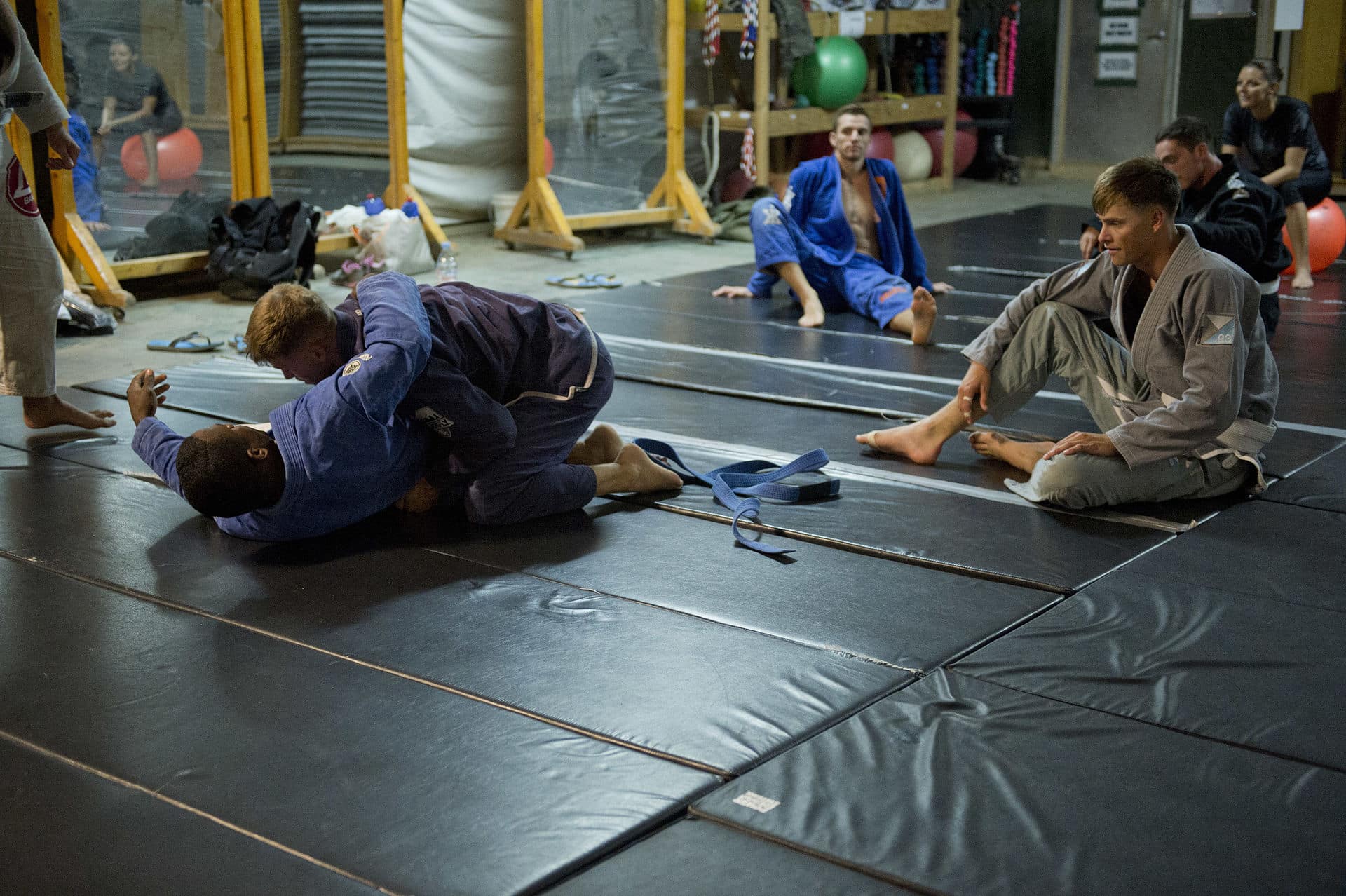
Don’t Muscle Through
Here’s a lesson I learnt quite early on – pumping iron like Schwarzenegger won’t necessarily give you a leg up in Brazilian Jiu Jitsu. Sure, strength can work in your favour during a match. However, when you’re just starting, focusing too much on using your brute force can hinder, rather than facilitate, your learning.
Brazilian Jiu Jitsu is a martial art that concentrates more on skill, technique, and strategy rather than raw power. In other words, it’s a thinking person’s sport. The old adage “brain before brawn” very much applies here.
As a beginner, your primary goal should be to absorb as much knowledge as possible. Learn from your instructor, learn from your training partners, and learn from your mistakes. Hint: you will be making a good many of these at the start, but remember, it’s all part of the learning curve.
When the time comes for you to roll (spar/fight), avoid using all the strength you’ve been studiously building at the gym. Understandably, suppressing the instincts firing off from your caveman’s brain might be a tad difficult. But here’s the catch – using raw strength over technique only works until a certain point. You’ll find yourself out of steam pretty quickly. In this scenario, techniques and the chess-like strategy of Brazilian Jiu Jitsu triumph over muscle strength.
Muscle memory can be your best friend or worst enemy in this game. If you constantly rely on your raw power, your body will automatically default to that in tense situations. This is not what you want. Instead, make it your goal to engrain the techniques and strategies you learn in your muscle memory. It’s not about overpowering your opponent; it’s about outsmarting them. So, leave your uber muscles at home, my friend, and bring only a can-do attitude and an eager-to-learn mind to the mats.
In a nutshell, don’t muscle through. Instead, think, learn, absorb, and, most importantly, enjoy every moment on the mats. A Brazilian Jiu Jitsu journey is not a race; it’s a gripping, thrilling marathon. So, hold onto your gi, my friend; you’re in for an extraordinary ride.
On the flip, if you find you are facing a bigger, younger, stronger, whatever opponent – let them burn themselves out on you. Focus on posture and base and let them gas out.
Focus on Surviving, Not Submitting
From the moment you step onto the mats, you may have a specific idea of what success looks like in Brazilian Jiu Jitsu. You might think it’s about getting as many submissions on your training partners as possible. But here’s a surprise for you – in your first class, your primary focus should be on surviving, not submitting.
That’s right, I said surviving. Now, I can practically hear your mind screaming: “Wait, am I about to be thrown into a lion’s den?” Not quite. Though it might sometimes feel that way at first – I’ve been there!
When we talk about ‘surviving’, it’s about not allowing your opponent to submit you or to overwhelm you with superior positions. This often means letting go of the notion of winning and learning how to ‘lose less’ instead. The sooner you accept that everyone gets tapped out, the better you’ll focus on what matters: Learning.
I went from a progression of ‘oh shit’ to ‘survive longer’ to ‘improve my position’ to ‘put pressure on them’ and am now moving into ‘try to find a submission’. Of course – this depends totally on the person I am rolling with – because you will quickly find different people with differing levels of experience mean very different rolls, which is awesome.
You’ll find yourself wrestling with more experienced students; chances are, they won’t allow you to execute the moves you’ve learned just yet. It’s crucial (and humbling) to remember that this is normal. It’s not a Hollywood film where you can be the tough hero who surprises the veterans. You’re a beginner, and that’s perfectly alright.
Remember, mastering any martial art is about the journey, not the destination. And in Brazilian Jiu Jitsu, ‘surviving’ is the first step of the journey towards mastery. It’s about learning to be comfortable in uncomfortable situations, understanding your body, its limitations, and ways of moving that initially feel completely counter-intuitive.
Tapping out to a submission doesn’t mean you’ve failed. Instead, it means you have identified a gap in your defences that you can work on. It’s a learning curve, and every tap is a lesson learnt.
Fight the urge to berserk, straining every muscle to escape or submit your partner. It’s a marathon, not a sprint. So play the long game, focus on defending, escape when possible, and most importantly, enjoy the process!
Remember, a calm sea never made a skilled sailor.
Summary: The Awesome Jiu-Jitsu Journey Begins
There you have it, folks – an essential guide to your first Brazilian Jiu-Jitsu lesson. Like plunging into icy bathwater, this might seem a bit overwhelming initially. However, the shock quickly subsides, giving way to a euphoria you may not find in any other sport.
I end with a bit of philosophy. These twists, turns, falls, and rises may seem like a tall order. But remember, a journey of a thousand miles begins with a single step, and Jiu-Jitsu is no different. So, whether you’re a fresh-faced novice or a rusty old-timer, don’t hesitate to take that first step onto the mat. I am glad I did.

